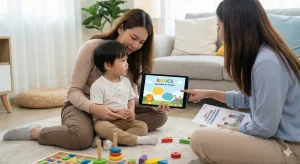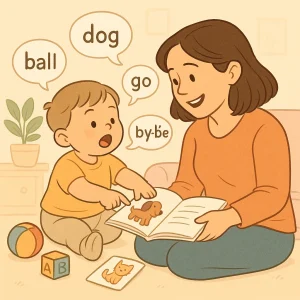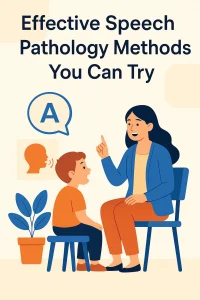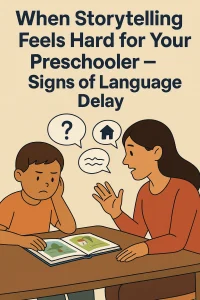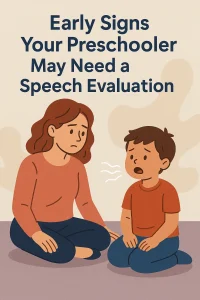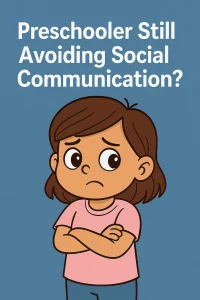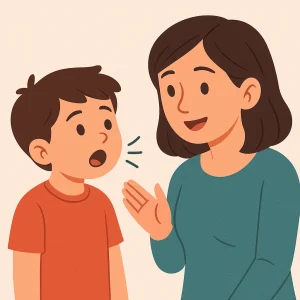Top 10 Speech Therapy Tools for Effective Communication
By Rajini D
Last Updated: September 4, 2024
Speech therapy tools can make a big difference in helping people improve their communication skills. Whether it’s a child learning new sounds or an adult working on their speech, these tools do more than just offer basic practice. They give hands-on, physical cues that go beyond just seeing and hearing, making therapy more engaging and effective.
Think of it like learning to play an instrument—you wouldn’t just watch videos; you’d want to feel the instrument. Similarly, these tools guide the tongue, lips, and other parts of the mouth to the correct positions and movements, making it easier and faster to learn new sounds.
Why Speech Therapy Tools Matter
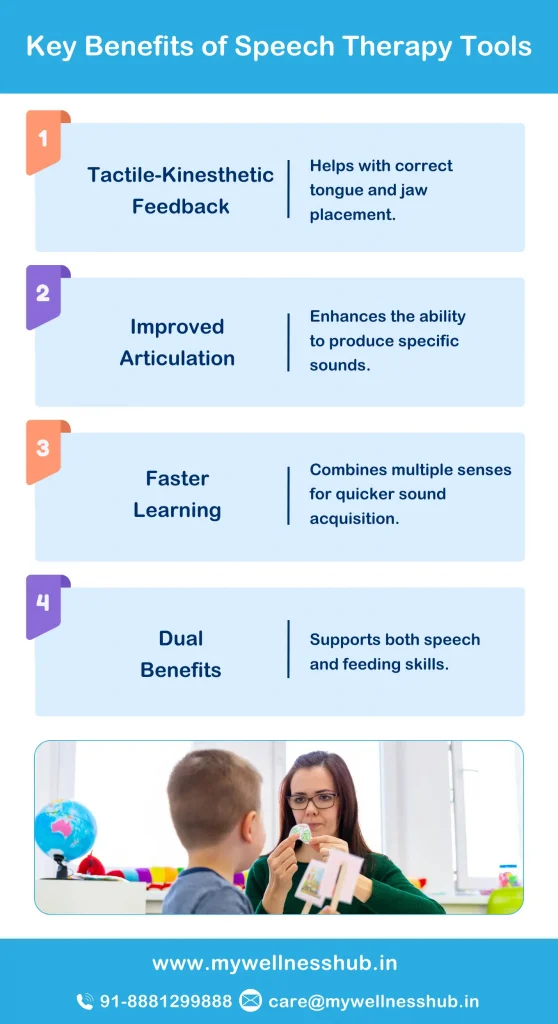
Speech therapy tools are important for helping people speak more clearly and effectively. These tools aren’t just about practicing—they’re about getting the movements just right. They guide the tongue, jaw, and other parts of the mouth to the correct positions needed for making sounds. For example, making the “r” sound can be tricky if you don’t know where your tongue should go. Tools like Speech Buddies provide exact feedback, making it easier to learn the correct placement.
One of the best things about using speech therapy tools is that they support learning through touch and movement. Unlike traditional methods that rely only on seeing and hearing, these tools let you feel the correct movements. This hands-on approach speeds up learning because it uses multiple senses—seeing, hearing, and feeling. For example, tools like Talktools Bilabial Shapes give specific touch cues for sounds like “m” and “p,” helping learners understand the right mouth movements more quickly.
Also read: How Speech Pathology Can Improve Communication
Top Speech Therapy Tools for Effective Communication
When it comes to speech therapy, having the right tools can make a world of difference. Let’s dive into some of the top speech therapy tools that can help improve communication skills by providing targeted support for various speech challenges.
Speech Buddies
Speech Buddies are specialized tools designed to help individuals master specific sounds, such as ‘l’, ‘r’, ‘s’, ‘sh’, and ‘ch’. They work by guiding the tongue to the correct position, making it easier to produce these sounds accurately. Suitable for a wide range of ages, Speech Buddies can be used by children as young as three with a therapist’s guidance, and older children can even use them independently. Their targeted approach makes them highly effective for those struggling with specific articulation issues.
Also read: How to Help Your Child Pronounce the “Ch” Sound
Talktools Bilabial Shapes
Talktools Bilabial Shapes are particularly useful for producing bilabial sounds like ‘m’, ‘p’, and ‘b’. These tools come in different shapes and colors, with each shape—square, triangle, and circle—corresponding to a specific sound. This visual and tactile association helps learners understand and remember the correct lip movements needed for each sound, enhancing the overall learning experience.
Talktools Tactile Tubes
For vowel production, Talktools Tactile Tubes are a valuable tool. They aid in achieving the necessary lip rounding required for vowels such as ‘oo’, ‘oh’, and ‘ah’. These tubes are especially beneficial for children with apraxia of speech, oral sensory issues, or poor muscle tone, as they provide the tactile feedback needed to master these sounds. By using varying diameters, the tubes help in the gradual transition from one vowel sound to another, making speech production smoother.
Talktools Apraxia Blocks
Talktools Apraxia Blocks are designed to help with jaw stability, which is crucial for producing vowel sounds correctly. These color-coded bite blocks assist in stabilizing the jaw at different positions, which is particularly helpful for children with speech challenges like apraxia. By focusing on jaw stability, these blocks help create a strong foundation for clear and consistent vowel production.
Talktools Horn Kit
The Talktools Horn Kit includes a series of horns that help improve airflow, a key component in speech production. By practicing with these horns, individuals can work on increasing the airflow needed for specific speech sounds, prolonging speaking ability, and even reducing drooling. This tool is great for those who need to work on breath control and airflow regulation as part of their speech therapy.
Talktools Straw Kit
The Talktools Straw Kit consists of a series of straws used in a hierarchical manner to develop essential speech production skills. Practicing with these straws can improve lip protrusion, tongue retraction, and graded jaw opening, all of which are necessary for accurate sound production. This tool is not only simple to use but also highly effective in supporting speech development through everyday activities like drinking.
Chewy Tubes
Chewy Tubes serve a dual purpose in speech therapy—they help improve biting and chewing skills while also providing oral sensory stimulation. Available in various textures and colors, Chewy Tubes cater to different needs, from soft textures for younger children to firmer options for older users. They’re particularly useful for individuals who need to strengthen their jaw muscles or have sensory processing challenges, making them a versatile addition to any speech therapy toolkit.
Talktools Tongue Tip Elevation/Lateralization Tool
The Talktools Tongue Tip Elevation/Lateralization Tool is specifically designed to help with tongue movements essential for producing sounds like ‘t’, ‘d’, ‘n’, and ‘l’. By using this tool, individuals can practice moving their tongue tip to the correct position, either horizontally or vertically, which is key to articulating these sounds accurately.
Talktools Tongue Depressor
The Talktools Tongue Depressor is another versatile tool that aids in improving jaw stability and achieving proper lip closure. With added sensory features like textured surfaces and flavors, this tool makes practicing these skills more engaging and effective. It’s particularly useful for those who need to work on foundational speech skills that involve jaw and lip control.
Nose Flute
The Nose Flute is a unique tool used to address challenges with nasal sounds like ‘m’, ‘n’, and ‘ng’. It helps individuals practice volitional airflow through the nasal passage, which is essential for producing these sounds correctly. Additionally, it can be beneficial for children who tend to breathe through their mouths, as it encourages nasal breathing, contributing to better speech production overall.
Top Speech Therapy Tools and Their Uses
| Tool Name | Targeted Sounds/Skills | Best For | Recommended Age |
|---|---|---|---|
| Speech Buddies | ‘l’, ‘r’, ‘s’, ‘sh’, ‘ch’ | Articulation issues | Ages 3 and up |
| Talktools Bilabial Shapes | ‘m’, ‘p’, ‘b’ | Bilabial sounds | All ages |
| Talktools Tactile Tubes | Vowel production (‘oo’, ‘oh’, ‘ah’) | Apraxia, poor muscle tone | All ages |
| Talktools Apraxia Blocks | Jaw stability, vowel sounds | Children with apraxia | All ages |
| Talktools Horn Kit | Airflow improvement for speech | Prolonged speaking, drooling | All ages |
| Chewy Tubes | Biting, chewing skills, jaw strength | Oral sensory issues | Infants to adults |
| Talktools Tongue Tip Tool | Tongue elevation/lateralization (‘t’, ‘d’, ‘n’) | Articulation | All ages |
| Nose Flute | Nasal sounds (‘m’, ‘n’, ‘ng’) | Hypo-nasal speech | All ages |
How to Choose the Right Tools for Your Needs
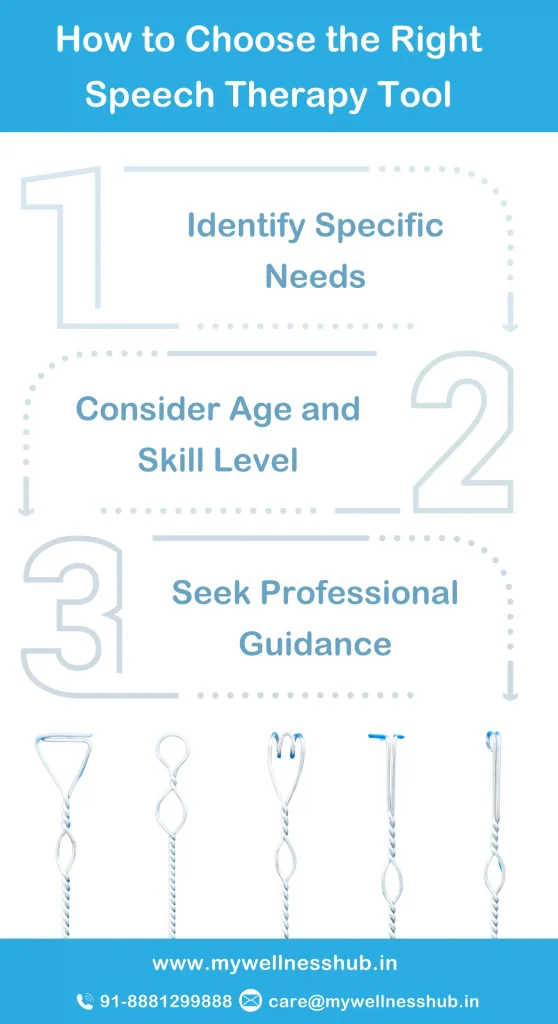
Selecting the right speech therapy tools can feel overwhelming, especially with so many options available. However, the key to making the best choice lies in understanding the specific speech challenges you or your child are facing. Here are some practical tips to help you pick the most effective tools for your needs.
1. Identify the Specific Speech Challenges
The first step is to identify the specific speech challenges that need addressing. For instance, if the primary issue is articulation, tools like Speech Buddies can help by guiding the tongue to the correct placement for sounds like ‘l’, ‘r’, and ‘s’. If the challenge is related to apraxia, Talktools Tactile Tubes or Apraxia Blocks might be more appropriate, as they provide tactile feedback to assist with sound production and jaw stability. Understanding these specific needs ensures that the tools you choose will directly target and support the areas that require improvement.
Read more: Speech Sound Disorders: Causes, Treatment and Strategies
2. Consider the Age and Abilities of the User
It’s important to select tools that are suitable for the user’s age and abilities. Some tools, like Chewy Tubes, come in different sizes and textures, making them adaptable for various age groups and sensory needs. Younger children might benefit from softer textures and simpler tools, while older children or adults may require more advanced tools that provide a greater level of challenge.
3. Use Tools Under the Guidance of a Qualified Speech Therapist
While speech therapy tools can be incredibly beneficial, their effectiveness often depends on proper use. That’s why it’s crucial to use these tools under the guidance of a qualified speech therapist. A therapist can not only recommend the right tools but also demonstrate the correct techniques and monitor progress, making adjustments as needed. This professional support ensures that the tools are used safely and effectively, maximizing their potential benefits.
4. Explore Resources and Guidance from Trusted Sources
For parents and therapists looking for additional support, resources like Wellness Hub offer valuable guidance on selecting and using speech therapy tools. From expert advice to a range of recommended products, platforms like Wellness Hub provide comprehensive support tailored to your specific needs. This can make a significant difference in choosing the right tools and implementing them successfully into therapy sessions.
Tips for Using Speech Therapy Tools Effectively
Using speech therapy tools can greatly enhance communication skills, but how you use them is just as important as which tools you choose. Here are some practical tips to help you get the most out of your speech therapy tools:
1. Be Consistent and Practice Regularly
Consistency is key when it comes to speech therapy. Regular practice with the tools not only reinforces the skills being learned but also helps to make them more natural and automatic. Aim to integrate tool use into daily routines, whether it’s during a dedicated therapy session or casual playtime. Even short, frequent practice sessions can lead to significant progress over time.
2. Start Simple and Build Up Gradually
If you’re just beginning to use speech therapy tools, start with the simpler options. For example, if your child is working on basic sounds, begin with tools that target easy-to-produce sounds and movements. As confidence and skills improve, you can gradually introduce more advanced tools that address complex sounds or specific challenges like apraxia or articulation. This step-by-step approach helps prevent overwhelm and keeps the learning process manageable and encouraging.
3. Monitor Progress and Adjust as Needed
Tracking progress is crucial to ensure that the tools are having the desired effect. Regularly observe how well the tools are working—are specific sounds becoming clearer? Is there less frustration during speech practice? If you notice that progress has stalled or if certain tools aren’t as effective as expected, don’t hesitate to make adjustments. Sometimes a small change, like altering the frequency of practice or switching to a slightly different tool, can make a big difference.
Conclusion
Speech therapy tools are a practical way to improve communication skills by offering hands-on guidance that helps with the correct placement of the tongue, lips, and jaw. These tools make it easier to master sounds and can be especially helpful for those with specific challenges like articulation issues or apraxia. Starting with simpler tools and progressing as skills improve, while ensuring consistent practice, can lead to significant improvements in speech clarity.
Exploring different tools is key to finding what works best for you or your child, as each person’s needs are unique. If you need more guidance, Wellness Hub provides access to qualified speech therapists and a range of tools to help you get started. With the right support and a bit of patience, you can make steady progress toward clearer, more confident communication. Remember, every small step forward is a win on this journey!
Frequently Asked Questions:
1. What are the most effective speech therapy tools for kids?
Effective speech therapy tools for kids include Speech Buddies for targeting specific sounds, Talktools Bilabial Shapes for bilabial sounds, and Chewy Tubes for improving chewing skills and jaw strength. These tools offer tactile feedback that helps children learn correct sound production.
2. How do speech therapy tools help improve communication?
Speech therapy tools provide tactile-kinesthetic cues that guide the correct placement of the tongue, lips, and jaw. This hands-on feedback enhances traditional visual and auditory methods, making it easier to master speech sounds and improve overall communication.
3. Can speech therapy tools be used at home?
Yes, many speech therapy tools are designed for home use under the guidance of a speech therapist. It’s important to follow the recommended instructions and practice regularly to ensure the best results. Tools like Talktools Horn Kit and Straw Kit are simple and can be easily integrated into daily routines.
4. How do I choose the right speech therapy tools for my child?
To choose the right speech therapy tools, identify your child’s specific speech challenges, such as articulation issues or apraxia. Start with simpler tools and gradually progress as skills improve. Consulting a speech therapist can provide personalized guidance on selecting the most appropriate tools.
5. Are speech therapy tools effective for adults?
Yes, speech therapy tools can be effective for adults who need to refine their speech skills or address specific articulation challenges. Tools like Speech Buddies and Talktools Apraxia Blocks are suitable for a wide range of ages, including adults, to improve speech clarity and communication.
6. What common mistakes should I avoid when using speech therapy tools?
Avoid over-relying on tools without integrating other therapy methods. It’s also crucial to understand the specific purpose of each tool to prevent misuse. Always use speech therapy tools under the guidance of a qualified speech therapist to ensure they are used correctly and effectively.
7. How often should I use speech therapy tools for best results?
Consistency is key. Regular practice, even for short sessions, can lead to significant progress. Aim to use the tools as recommended by your speech therapist, typically incorporating them into daily routines to reinforce learning and improve speech skills.
8. Do speech therapy tools help with feeding issues?
Yes, many speech therapy tools, like Chewy Tubes and Talktools Tactile Tubes, are designed to address both speech and feeding challenges. These tools can help improve jaw strength, tongue movement, and lip control, which are important for both clear speech and effective feeding skills.
9. Can speech therapy tools be used without a therapist?
While some tools can be used at home, it is best to use them under the guidance of a speech therapist. A professional can provide proper instructions, ensure correct usage, and adjust techniques as needed to suit the individual’s specific needs, making the therapy more effective.
10. How long does it take to see results with speech therapy tools?
The time it takes to see results can vary depending on the individual’s specific challenges and the consistency of practice. Regular use of the appropriate tools, along with other therapy methods, can lead to noticeable improvements in a few weeks to months. Patience and consistent effort are key to success.
About the Author:
Rajini Darugupally
M.Sc., Speech-Language Pathologist (9+ years of experience)
Rajini is a passionate and dedicated Speech-Language Pathologist with over 9+ years of experience, specializing in both developmental speech and language disorders in children and rehabilitation in adults. Driven by a desire to empower each individual to find their voice, Rajini brings a wealth of experience and a warm, genuine approach to therapy. Currently, at Wellness Hub, she thrives in a team environment that values innovation, compassion, and achieving results for their clients.
Book your Free Consultation Today
Parent/Caregiver Info:
Client’s Details:
* Error Message
